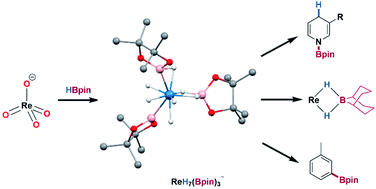Synthesis and structures of anionic rhenium polyhydride complexes of boron–hydride ligands and their application in catalysis†‡
Abstract
The rhenium complex, [K(DME)(18-c-6)][ReH4(Bpin)(η2-HBpin)(κ2-H2Bpin)] 1, comprising hydride and boron ligands only, has been synthesized by exhaustive deoxygenation of the commercially available perrhenate anion (ReO4−) with pinacol borane (HBpin). The structure of 1 was analysed by X-ray crystallography, NMR spectroscopy, and DFT calculations. While no hydrides were located in the X-ray crystal structure, it revealed a trigonal arrangement of pinacol boron ligands. Variable-temperature NMR spectroscopy supported the presence of seven hydride ligands but further insight was hindered by the fluxionality of both hydride and boron ligands at low temperature. Further evaluation of the structure by Ab Initio Random Structure Searching (AIRSS) identified the presence of hydride, boryl, σ-borane, and dihydroborate ligands. This complex, either isolated or prepared in situ, is a catalyst for the 1,4-hydroboration of N-heteroaromatic substrates under simple operating procedures. It also acts as a reagent for the stoichiometric C–H borylation of toluene, displaying high meta regioselectivity in the borylated products. Reaction of 1 with 9-BBN resulted in HBpin substitution to form the new anionic tetra(dihydroborate) complex [K(DME)(18-c-6)][Re(κ2-H-9-BBN)4] 4 for which the hydride positions were clearly identified by X-ray crystallography. The method used to generate these isolable yet reactive boron–hydride complexes is direct and straightforward and has potential utility for the exploitation of other metal oxo compounds in operationally simple catalytic reactions.

- This article is part of the themed collection: Celebrating our 2021 Prizewinners


 Please wait while we load your content...
Please wait while we load your content...